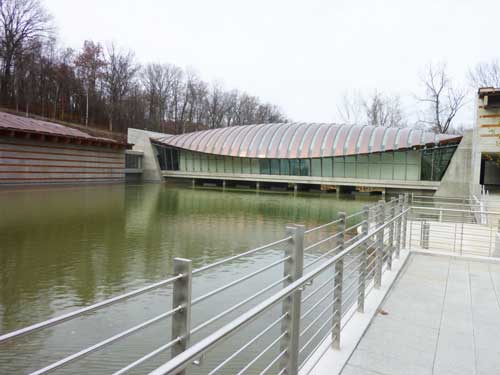
Crystal’s Chris Crossed? The Bentonville museum’s soon-to-depart founding curator, Chris Crosman
Now that we’ve all dutifully returned to our computers after quaffing eggnog and eating latkes (not a good pairing) during the concurrent Christian and Jewish seasonal celebrations, it’s time for us to stop opening presents and start opening the saved tabs on our web browsers. Let’s begin catching up on all that art news we’ve missed.
We’ll start with this: At long last, the NY Times has found its way to Alice’s Palace in the Ozarks, with an insightful and favorable review by Roberta Smith (online today, hardcopy tomorrow).
The money quote, from Crystal Bridges’ point of view, is this:
Crystal Bridges is poised to make a genuine cultural contribution, and possibly to become a place of pilgrimage for art lovers from around the world.
“Around the world”? My guess is that “around the country” is more realistic (with a smattering of international visitors). Still, the founder and staff of the Bentonville, AR, museum could not have asked for a better endorsement.
But wait a minute! what’s happened to the site’s manmade ponds—architect Moshe Safdie‘s distinctive water feature? Roberta writes that they “unfortunately were empty and still being worked on when I visited this month.”
Really? When I visited last month, the lower pond was full:

And the upper pond looked like this:

I had then been assured (by facilities manager David Burghart) that both would be up and flowing within about a week after my Nov. 16 visit.
Instead, there seems to have been negative progress. Chris Crosman, the museum’s founding curator, told me in an e-mail today (responding to my query) that he had been “told that the lower pond developed a ‘leak.’ In order to find and fix that problem, they needed to drain that pond. The lower pond is now being re-filled and the upper pond will follow in due course (mid-January is the current estimate).”
A pond that laps right up against art galleries inevitably makes art lovers a bit nervous. Even the museum’s director, Don Bacigalupi, admitted to an interviewer that the close proximity of art and water had initially worried him, until he felt more confident about the engineering. A leaking pond that laps up against galleries can only reactivate such qualms.
Also having maintenance issues (not mentioned by Roberta) was James Turrell‘s Skyspace. It was completely closed for a time due to malfunctions in the timing of its lighting system and it is now open only on a limited basis, rather than continuously as originally planned. David Houston, the museum’s curatorial director, had told me that some visitors who entered during off hours (when there were no changing colored lights to enliven the space) reacted angrily when they sat there and nothing happened. They needed to be given more context for understanding this meditative, atmospheric piece, he said.
On the two occasions when I passed “Skyspace” during the daytime last month, it was gated:

What’s more, the underside of its entrance canopy looked much the worse for wear, less than two weeks after the museum’s opening:

Another thing that’s changed at Crystal Bridges (not mentioned by Roberta, understandably) is Crosman’s professional status. Not publicly announced is that after six years working for the museum, he will depart as of Dec. 31. His title last January changed from chief curator to founding curator, shortly before an expanded curatorial team was brought on board.
“I am looking forward to getting back to family and friends in Maine, and will also miss many new ones here,” said Chris, who was previously director of the Farnsworth Museum, Rockford, ME. He felt he could not discuss his leavetaking in more detail. I do know that when I had asked for time to speak with him during my visit (because he has the longest institutional memory of anyone there, aside from founder Alice Walton), I was told that he wasn’t around. A short time later, I spotted him in the cafeteria, where we sat down together (at the table in the top photo) for a cordial chat.
But back to Roberta: While mostly impressed by the museum’s “running start,” she also identified what struck her as two major failings: One was omission of folk art (although there was one folk-like painting in the galleries, as shown in my CultureGrrl Video at the end of this post).
Roberta’s other complaint concerned “a major failure of the museum’s design”—its neglecting to “exploit the site’s abundant natural light inside the galleries. This is an amazing shortcoming in an institution so clearly devoted to both painting and the natural world.”
Actually, this wasn’t a “failure of the museum’s design.” It was the result of the staff’s alteration of architect Moshe Safdie‘s design for the museum. As I reported in my review of the architecture:
Safdie [whom I interviewed] expressed some dissatisfaction with the decision by museum officials to scotch his initial plans, as publicized in a previous Crystal Bridges press release, to include skylights in every gallery. After Don Bacigalupi became the museum’s director (October 2009), “there were different views,” Safdie told me, “and the skylights were removed” before they were ever built. Eschewing skylights permitted the curators to install light-sensitive works-on-paper in close proximity to the paintings.
Roberta was also ambivalent about other aspects of the architecture, which to her “seems slightly confused” and “rather coarsely detailed.” evoking “aspects of the Getty’s hilltop campus in Los Angeles, of Frank Lloyd Wright‘s Fallingwater in western Pennsylvania and a fancy theme park, albeit one minus the rides.”
We still await an Arkansas journey by the paper’s chief architecture critic, Michael Kimmelman. When last heard from, he was perusing a park in Madrid.
As for Roberta’s customary area of expertise—the museum’s collection—she judges it to be “substantial enough to merit the use of the word “masterworks” in the title of its opening exhibition.”
In other words, Alice’s $445.44-million art budget (pre-2011) was well spent.
